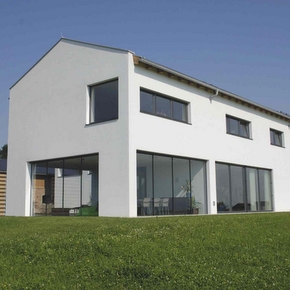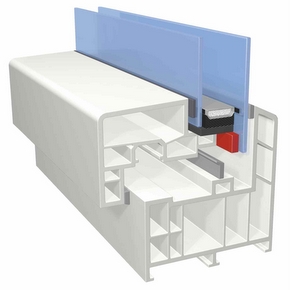
Let natural light in but keep the cold out
 Jeff Richards, Sika Product Manager, explains why modern structural glazing systems featuring modern bonding systems enable architects and contractors to maximise natural light as a fundamental element of contemporary architecture.
Jeff Richards, Sika Product Manager, explains why modern structural glazing systems featuring modern bonding systems enable architects and contractors to maximise natural light as a fundamental element of contemporary architecture.
The role of natural light
It stimulates the eye and mind, it enhances well-being, is free and doesn’t require electricity. There is no denying that natural light is a fundamental element of contemporary architecture. From energy savings and improved occupant comfort to greater productivity in commercial applications, the positive effect of daylight is a widely acknowledged fact across the construction industry.
It’s a proven fact that natural light plays a crucial role in sustainable design and glazing is one of the few constants in every building. Glass allows more light into a building which leads to naturally-lit interiors, improved thermal performance and most importantly – more contented occupants. Over the years as more and more research proves that natural light improves well-being and productivity there has been a desire for larger expanses of glazing. With this comes the aesthetic demand for slimmer, less obtrusive frames.
Structural glazing
Structurally-glazed systems offer one method of achieving large expanses of glazing. In Europe, especially, there is more of a trend towards structural glazing. The technology on the continent is more advanced which helps fulfil the greater demand. However, with the UK government pledging to reduce greenhouse gas emissions by at least 80% by 2050, the pressure is on to improve the thermal performance of new commercial and private buildings across the UK and an increasing number of architects and housebuilders are opting for structural glazing.
Traditional structural glazing has featured steel reinforcement but there is an increasing trend towards adhesives solutions when it comes to bonding glass inside window frames or sashes. There are a number of aesthetic and thermal gains to be had by adopting this method.
Firstly, when glass is chemically adhered to a frame it means the PVC or metal frames themselves do not need to be as big which therefore allows more light into a building. The adhesive provides an incredibly strong bond to the frame, helping reduce the need for larger sashes, which also allows more light through.
Structural bonding
 With structurally-bonded glass negating the need for steel reinforcement in frames, it prevents cold bridging between the building’s exterior and interior, thus improving a building’s thermal envelope.
With structurally-bonded glass negating the need for steel reinforcement in frames, it prevents cold bridging between the building’s exterior and interior, thus improving a building’s thermal envelope.
Structural bonding not only increases thermal efficiency it saves on costs incurred by the steel within the frame. There is also the question of long-term performance. Glass can shift or twist within a steel frame over time due to the constant opening and closing of windows, leading to distortion which can make the opening and closing operation quite difficult. In Europe particularly, this issue was found to be successfully addressed by the use of structural bonding as the glass remains strong and immoveable.
By reducing the size of window frames and sashes, structural bonding is a boon to architects, giving them more of a freehand in terms of design. It means windows can play a stylish, as well as functional role in a building’s make-up.
Different bonding systems are available, depending on the window system being fitted. Sika’s Sikasil Window Technology (WT) range provides the ideal solution, offering excellent adhesion to most relevant substrate as well as outstanding UV and weathering resistance, flexibility over a wide temperature range and long-term durability.
Four vital requirements
With a continued reliability on glass, modern structural glazing systems featuring modern bonding systems will enable architects and contractors to fulfil four vital requirements – improved aesthetics; increased light; better thermal performance and, most importantly, happier occupants.
Sika Limited
Watchmead
Welwyn Garden City
Hertfordshire
AL7 1BQ
Telephone: +44 (0) 1707 394444
Visit Supplier's page
Latest news

11th April 2025
Don’t Do a Dave! It’s Time to Lock FIT Show 2025 in Your Calendar!
It’s that time again – FIT Show is back! You could be forgiven for thinking there won’t be much new to see when FIT Show returns to the NEC from 29 April – 1 May. Wrong!
Posted in Articles, Building Industry Events, Building Industry News, Building Products & Structures, Building Services, Continuing Professional Development (CPD's), Exhibitions and Conferences, Information Technology, Innovations & New Products, Restoration & Refurbishment, Retrofit & Renovation, Seminars, Training
11th April 2025
Insight Data: Boost construction success with project and prospect data
For those working in construction – in whatever capacity – the last few years haven’t been much fun. And according to the latest statistics, it would seem the challenges are continuing – Alex Tremlett, Insight Data’s Commercial Director, has more…
Posted in Articles, Building Industry News, Building Services, Information Technology, news, Research & Materials Testing
11th April 2025
ASSA ABLOY EMEIA: Learn how to tackle the security challenges of digitalising access with insights from industry experts
In a new series of videos, experts in various specialisms within ASSA ABLOY share their expertise on digital access, including the complexities to overcome and the range of benefits for those who get digital access right…
Posted in Access Control & Door Entry Systems, Architectural Ironmongery, Articles, Building Industry News, Building Products & Structures, Building Services, Doors, Facility Management & Building Services, Information Technology, Innovations & New Products, Posts, Restoration & Refurbishment, Retrofit & Renovation, Security and Fire Protection, Videos
10th April 2025
Geberit completes 150 Acts of Kindness
Geberit has raised nearly £14,000 for various charities through its ‘150 Acts of Kindness’ initiative, a year-long programme of fundraising and volunteering to mark the company’s 150th anniversary in 2024.
Posted in Articles, Bathrooms & Toilets, Bathrooms, Bedrooms & Washrooms, Building Industry Events, Building Industry News, Building Products & Structures, Building Services, Charity work, Drainage, Interiors, Pipes, Pipes & Fittings, Plumbing, Restoration & Refurbishment, Retrofit & Renovation
 Sign up:
Sign up: